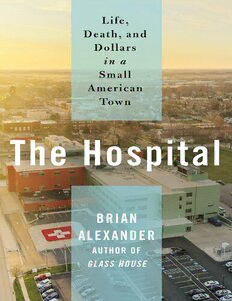
The Hospital: Life, Death, and Dollars in a Small American Town PDF
Preview The Hospital: Life, Death, and Dollars in a Small American Town
Begin Reading Table of Contents About the Author Copyright Page Thank you for buying this St. Martin’s Press ebook. To receive special offers, bonus content, and info on new releases and other great reads, sign up for our newsletters. Or visit us online at us.macmillan.com/newslettersignup For email updates on the author, click here. The author and publisher have provided this e-book to you for your personal use only. You may not make this e-book publicly available in any way. Copyright infringement is against the law. If you believe the copy of this e-book you are reading infringes on the author’s copyright, please notify the publisher at: us.macmillanusa.com/piracy. To the memory of Bruce Alexander, writer, who kept waiting to see a doctor until his Medicare kicked in A Note to Readers In some cases, the names of people have been changed in order to comply with applicable medical care privacy law, or to protect anonymity. Those names marked by an asterisk are fictitious. In several cases, minor details of scenes have also been altered to avoid disclosing identities. We have assembled the most enormous medical establishment ever conceived, and people are sicker than ever! —Paddy Chayefsky, The Hospital, 1971 They’re all sick when they come in here. They’re horribly unhealthy. If they were healthier I’d see a lot fewer. —Lori Bolton-Sell, chief probation officer, Williams County, Ohio, 2019 Prologue There was nothing special about that morning. It was just a winter Monday—cold, but of course it would be cold, being almost mid-February 2019. Nothing like twelve days before, when Jim Watkins, the chief of the Williams County Health Department, had taken a photo of his car’s instrument panel to immortalize the reading of –15. A couple of sub-zero days in midwinter weren’t unusual for this far northwest corner of Ohio, but even the crusty old farmers agreed that fifteen below was a little extreme. At the Seasons coffee shop, talk about the “polar vortex” had faded, and High Street and Main Street had been plowed. Some side streets were still coated, but passable, and piles of crunchy snow, turning grimy, took up a few parking spaces in the CVS lot. The lawn of the county courthouse in the Bryan town square was covered in white, offsetting its extravagant Baroque/Romanesque mishmash of red brick and sandstone. Long strands of Christmas lights still swooped down from its peak. The main county roads and the state routes were clear, too, so most people were getting to work okay. Everybody kept an eye out for deer leaping out of frozen cornfields—the roadsides were dotted with the carcasses of struck deer this winter. Drivers sometimes ended their commutes in the ER because of them, or because they slid on the black ice that lay camouflaged like land mines. Phil Ennen slipped into his long, brown overcoat, wrapped a scarf around his neck, and placed a rakishly wide-brimmed fedora on his head to prepare for his own commute—a walk of about 150 yards across Garver Park to the hospital, where he was chief executive officer. He could see the building out his front door. At night, watching TV or lying in bed, he could hear emergency medical helicopters arrive and take off from the hospital’s landing pad. Only 8,500 people lived in Bryan, and Ennen knew all of them, or so it seemed, so he’d wonder who was strapped onto the gurney and what had happened and how bad it must have been to require flying the patient to Toledo or Fort Wayne. He was fifty-five years old. He’d worked at the hospital for thirty-two years. He called it “my shop,” as if he were a cobbler making shoes. Ennen was protective to the point of defensiveness about his shop. The aesthetic critique was one example. The hospital stood out in a town of late nineteenth- and early twentieth- century architecture, especially since the 2009 rebuild. The rectangular orange and green exterior cladding panels and the intersections of the building’s wings created a modernist, alien dissonance. A few residents had taken to calling it “the Lego blocks place,” as in, “You goin’ over to the Lego blocks place to get yerself checked out?” What really got to him, though, was the “Band-Aid station” crack. “That place is just a Band-Aid station,” people would say, and Ennen would smile to cover his seething. He grew up in Bryan. Most knew him as one of the Ennen brothers, Mary Helen and Jack’s kids. His father owned a small manufacturing company up in the village of Pioneer that made parts for Detroit’s cars. His mother worked at the hospital he now ran. He met Mary, his wife, in the first grade at St. Patrick Catholic School. She was the daughter of Jim Ebersole, the barber who owned Mel and Jim’s Barber Shop on the square. So Ennen understood the small-town way of simultaneously demanding community respect from outsiders while internally scoffing at any homegrown institution as second-rate. He steamed just the same. Sometimes it felt like the town—even the whole county— didn’t give a damn about the work he did on its behalf. Running a small independent community hospital was never
